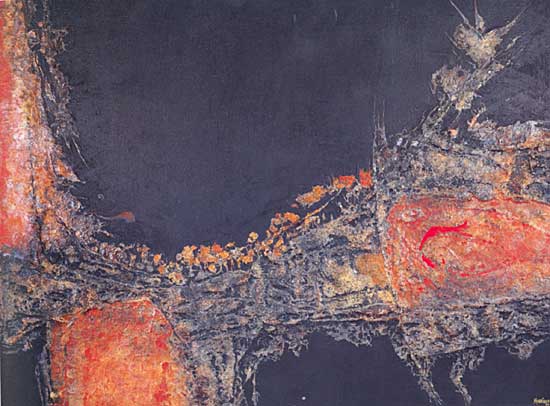César Manrique, Pintura 1958-1992
César Manrique (1919–1992) was born in Arrecife, the capital of Lanzarote, an island that had a decisive presence in his life and work. The landscape of his childhood memories was the source of much of his pictorial imagery and had great significance for his subsequent perception of the world and for his painting. After finishing his studies at the Academia de Bellas Artes de San Fernando in Madrid—the city where he lived from 1945 to 1964—he frequently exhibited his paintings in Spain and also abroad. He began to explore non-figurative art after spending several months in Paris in the early fifties. In the late fifties, under the influence of Fautrier and Dubuffet, among others, his work—like that of some other Spanish painters, such as Antoni Tàpies, Lucio Muñoz and Manuel Millares—became connected with Art Informel. Manrique’s paintings abandoned all allusions to reality and he pursued a leaning to abstraction, investigating the qualities of matter with explicit references to the textures and colour of volcanic lava, which became an essential focus in his compositions. Throughout his artistic career he remained true to this expressive language, consolidated in the sixties and early seventies, which is undoubtedly the period of his greatest splendour as a painter. After travelling to various parts of the world, in 1964 César Manrique went to live in New York. Ties of friendship with personalities of the world of culture in America enabled him to obtain first-hand knowledge of the Abstract Expressionism of Rothko and Pollock, the Pop art of Warhol and Rauschenberg, kinetic art, and so on. In 1966 Manrique returned definitively to Lanzarote and settled there. In the island, where the tourist industry was just beginning to develop, he promoted a model of intervention in the landscape based on sustainability, seeking to safeguard Lanzarote’s natural and cultural heritage. César Manrique cultivated a variety of creative languages—including painting, sculpture, urban development and public art—and in his artistic output as a whole there is a clear desire for integration with the natural environment. A syncretic, totalising aim—“total art”, as he called it—which he made explicit in his designs for public areas. The exhibition at the IVAM will concentrate on César Manrique’s more intimate paintings and on the work that singles him out in the context of his generation, his paintings of matter, texture and chromaticism with references to the geology of the island, Informel landscape painting, which became part of his expressive vocabulary in the late fifties (the earliest of these works are dated 1959) and accompanied him for the rest of his life. The richest and most essentialist distillation of this activity appeared in the sixties, coinciding with a period that he spent in Madrid and New York. The exhibition will review this central stage in his output as a painter, emphasising the work produced in the sixties and seventies.



